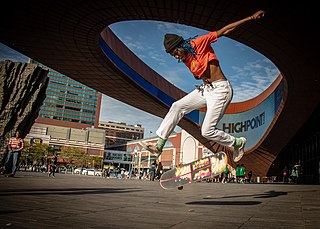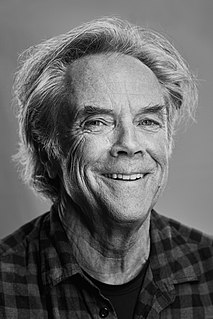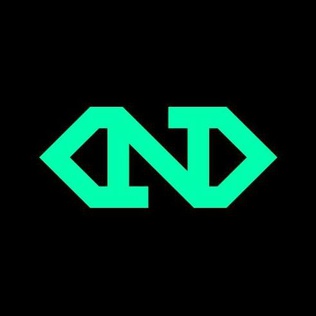
Skateboarding is an action sport originating in the United States that involves riding and performing tricks using a skateboard, as well as a recreational activity, an art form, an entertainment industry job, and a method of transportation. Skateboarding has been shaped and influenced by many skateboarders throughout the years. A 2009 report found that the skateboarding market is worth an estimated $4.8 billion in annual revenue, with 11.08 million active skateboarders in the world. In 2016, it was announced that skateboarding will be represented at the 2020 Summer Olympics in Tokyo, for both male and female teams.

Anthony Frank Hawk, nicknamed Birdman, is an American professional skateboarder, entrepreneur, and the owner of the skateboard company Birdhouse. He completed the first documented "900" skateboarding trick in 1999, licensed a video game series named after him published by Activision that same year, and is a pioneer of modern vertical skateboarding. He retired from competing professionally in 2003 and is regarded as one of the most influential skateboarders of all time.

John Rodney Mullen is an American professional skateboarder who practices freestyle skateboarding and street skateboarding. He is considered the most influential street skater in the history of the sport, being credited for inventing numerous tricks, including the flatground ollie, kickflip, heelflip, impossible, and 360-flip. As a result, he has been called the "Godfather of Street Skateboarding".

Dogtown and Z-Boys is a 2001 documentary film produced by Agi Orsi and directed by Stacy Peralta. The documentary explores the pioneering of the Zephyr skateboard team in the 1970s and the evolving sport of skateboarding. Using a mix of film of the Zephyr skateboard team (Z-Boys) shot in the 1970s by Craig Stecyk, along with contemporary interviews, the documentary tells the story of a group of teenage surfer/skateboarders and their influence on the history of skateboarding culture.
Natas Kaupas is an American professional skateboarder. He grew up in South Santa Monica, California, in the area known as Dogtown and is of Lithuanian descent. He is often referred to as one of the first true professional street skateboarders.

David Carson is an American graphic designer, art director and surfer. He is best known for his innovative magazine design, and use of experimental typography. He was the art director for the magazine Ray Gun, in which he employed much of the typographic and layout approach for which he is known. In particular, his widely imitated aesthetic defined the so-called "grunge typography" era.

Tony Alva is an American skateboarder, entrepreneur, and musician. He was a pioneer of vertical skateboarding and one of the original members of the Zephyr Competition Skateboarding Team, also known as the Z-Boys. The Transworld Skateboarding Magazine ranked him eighth in its list of the "30 Most Influential skateboarders" of all time.

Jay J. Adams was an American skateboarder who, as a teen, was the youngest member of the Zephyr Competition Skateboarding Team (Z-Boys). His spontaneous freestyle skateboarding style, inspired by ocean surfing, helped innovate and popularize modern skateboarding. His aggressive vertical tricks make him one of skateboarding's most influential stylists. Adams died of a heart attack on August 15, 2014.
Guy Mariano is an American professional skateboarder. Mariano first gained recognition at the age of 14 for his video part in the Blind Skateboards video Video Days (1991).

Cover art is a type of artwork presented as an illustration or photograph on the outside of a published product such as a book, magazine, newspaper (tabloid), comic book, video game, music album, CD, videotape, DVD, or podcast. The art has a primarily commercial function, for instance to promote the product it is displayed on, but can also have an aesthetic function, and may be artistically connected to the product, such as with art by the creator of the product.
Craig R. Stecyk III is an American artist, writer, photojournalist, and filmmaker who has documented and influenced the surf, skate, and snowboarding cultures.
Mark Gonzales, also known as "Gonz" and "The Gonz", is an American professional skateboarder and artist. He is known as a pioneer of modern street skateboarding and was named the "Most Influential Skateboarder of All Time" by the Transworld Skateboarding magazine in December 2011.

Nike Skateboarding, primarily known as Nike SB, is the Nike brand for its line of shoes, clothing, and equipment for skateboarding. Nike Skateboarding won the 2020 Webby People’s Voice Award for Best Home/Welcome Page in the category Web.

Chris Cole is an American professional skateboarder. As of September 2020, his sponsors are Fallen Footwear, Monster Energy, Bones Bearings, Cult Crew, Thunder Trucks, Spitfire Wheels, Stance, Kershaw Knives, Grizzly Griptape, GoPro, Indian Motorcycles, cbdMD, Remind Insoles, and most recently Zero Skateboards.
Peggy E. Oki is an American skateboarder, surfer, artist, and environmental activist. She was an original member of the Z-Boys and competed with the Zephyr Competition Team in the 1970s. She was the only female member of the Z-Boys.

Nemo Design is a brand design agency and creative workshop based in Portland, Oregon, in the United States. The company was established by Jeff Bartel, a snowboarding photographer Trevor Graves, and by Chris Hotz in 1999. It offers a variety of services, specializing in active lifestyle and culture brands.
Todd Bratrud is an illustrator and artist born in 1975 in Crookston, Minnesota, on the same day as the wreck of the S.S. Edmund Fitzgerald. He is the owner of Send Help skateboards, previously known as The High Five skateboards. He is currently living in Grand Forks, North Dakota. He lived in Minneapolis, Minnesota until he moved to Santa Cruz, California in 1999 to become the art director of Consolidated Skateboards. He has created hundreds of graphics for skateboards, stickers, advertisements and apparel for companies like Consolidated Skateboards, Flip Skateboards, Birdhouse Skateboards, Enjoi Skateboards, Black Label Skateboards, Creature Skateboards, Real Skateboards and Volcom. He is also an illustrator and blogger for The Skateboard Mag. Examples of his skateboard graphics can be found in the book Disposable, published by Ginkgo Press.

Jim Evans, sometimes known as T.A.Z., is an American painter, printmaker, and creative director who was a contributing figure in the visual art movement known as underground comix. After a successful career as a comic illustrator, Evans worked as a painter, poster maker, and owner of the digital design group Division 13.
Jaime Reyes is a goofy-footed American skateboarder from Hawaii. Reyes is a pioneer in women's street skating. As of 2020, Reyes is one of only three women to grace the cover of Thrasher Magazine.
Marc Vallée is a British documentary photographer who has photographed youth culture, in Paris, Berlin, and London where he lives. He has made work about the tension between public and private space in the context of graffiti, skateboarding and queer cultures. Vallée has self-published in zines and shown in group exhibitions at the Museum of London and Somerset House.











